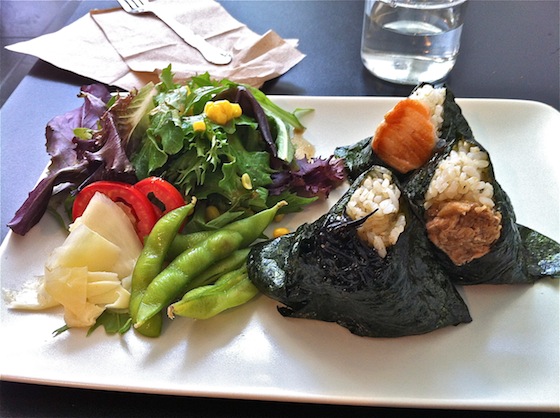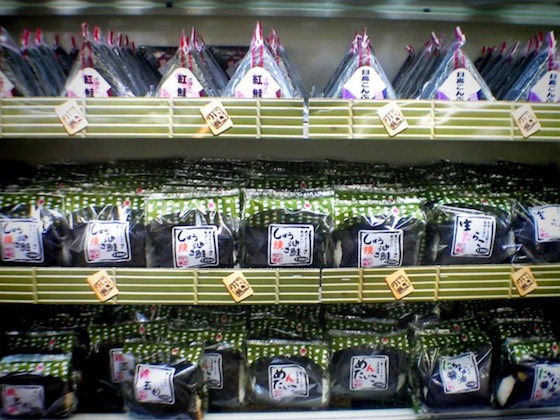
I first sampled his rice triangles generously topped with eggplant, hijiki and spicy shrimp at the Cinema Café in Japantown’s New People building, during a tasting tour that I wrote about for BAB. (Note: I so enjoyed that Edible Excursions tour, that I am now one of the EE guides and lead Japantown tasting tours several Saturdays a month).
I was eager to visit his new restaurant and try some of his many veggie, meat and seafood toppings. Arriving before noon, it was easy to snag a spot at one of the five tiny tables and munch my lunch as a steady stream of trendy young office workers moved through an orderly line and took their lunches in compostable boxes to go.
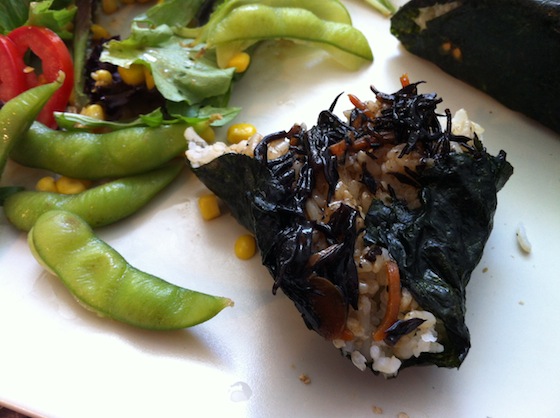
hijiki and shredded carrots
With 17 choices, it's not easy to narrow it down to a set of three. I picked salmon, teriyaki chicken and hijiki (seaweed with shredded carrots), which came with a salad, edamame and pickled ginger. This is comforting, finger food (except for the salad) with a trio of balanced textures: soft warm rice, crunchy nori (if you eat it right away) and satisfying toppings. Light, healthy and flavorful.
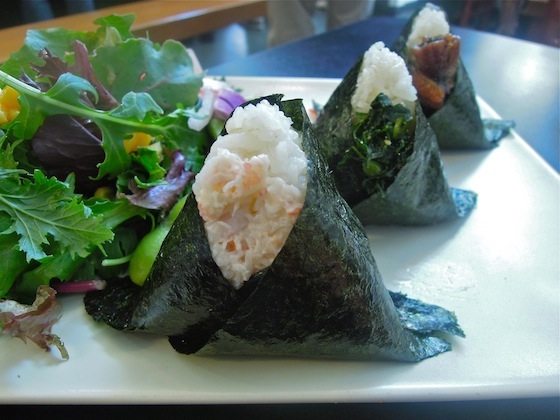
onigilly topped with snow crab salad, sesame kale and broiled unagi
Onigilly's menu features traditional Japanese flavored toppings, such as salmon, pickled plum, lotus root and stinky-smelling, but good-for-you-because-it's-fermented natto (soy beans). Plus a range of non-traditional combos, such as teriyaki tofu, spicy bacon cooked with garlic butter and sesame kale.
Koji has been selling his nori-wrapped rice packets and toppings from his food cart at Off the Grid Fort Mason, Civic Center Farmers Market and other locations since he completed the food incubation program at La Cocina. Executive Director, Caleb Zigas, explains that Koji’s "motivation, talent, entrepreneurial spirit and product quality" won him one of the few spots awarded to men in the program that prioritizes immigrant women. He was also the first Japanese person to go through La Cocina's training. And now, Mariko Grady, a current La Cocina participant, supplies Onigilly with its fermented foods.
Koji is from southern Japan. While in college there he worked in a restaurant for five years, ironically one that focused on pizza, pasta and wine.Then he started working in a tech company and came to the Bay Area on a business trip and predictably fell for our weather, culture and people.
I interviewed him about his rice-ball business and edited his answers for clarity and length.
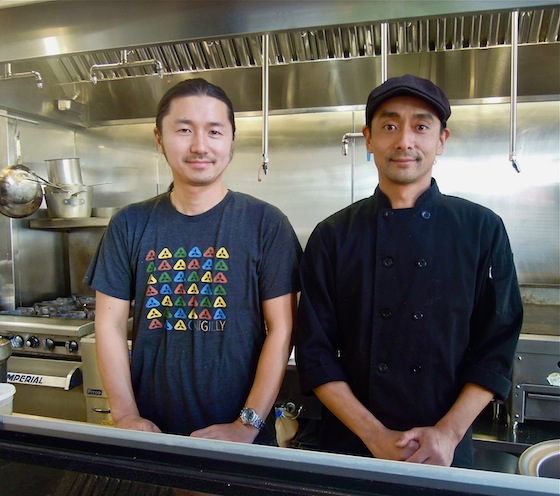
Koji Kanematsu and chef Adachi Hiroyuki
How did you come up with the idea for your business?
KK: When I moved here 6 years ago, I found it strange that there were sushi restaurants on every block, but the onigiri snacks that we can buy everywhere in Japan were nowhere to be found. The Japanese friends I met here all missed the same taste of home and urged me to start a business to fill this need.
So did you start with the onigilly the way you make them now?
KK: No, I started with a traditional Japanese style rice ball and tried it out on my Irish roommate and his American friends. They said it was okay, but they wouldn't eat it because it had too much rice and not enough filling. I got the idea to switch brown rice for the traditional white rice, then asked my friend (and now business partner) Adachi Hiroyuki–-who was executive chef for the Tsunami sushi restaurants--if he had any ideas how to make this onigiri for Americans? Adachi came up with the perfect fusion of elements: more filling placed on the top of the triangle of brown rice and an expanded array of traditional and non-traditional toppings.
You say that onigiri has a long history. What do you mean?
KK: Well, they found fossilized rice balls from the Yayoi Period, about 2300 years ago. And in the Middle Ages (1200-1600) samurai used to take onigiri along when they were fighting a war. The traditional filling of ume pickled plum, helped keep the rice balls fresh. Farmers used to eat the portable snacks too, and office workers--they're the perfect lunch.
(At this point, chef Adachi Hiroyuki joins the conversation). I notice, chef, that your menu is already changing with the seasons.
AH: Yes, we're saying goodbye to eggplant and shishito (little peppers) but we'll have new flavors for the fall like chard, kabocha squash, sesame kale, beet greens with jalapeno and miso-roasted fennel.
What are your plans for the future?
AH: As soon as we get our liquor license, we plan to stay open later and add an izakaya bar, with beer, sake, shochu (a barley vodka) and appetizers.
KK: Eventually, we want to open 500 Onigilly restaurants around the country.
AH: We want to educate people about how to eat healthy.
KK: And expand into serving onigilly for school lunches.
